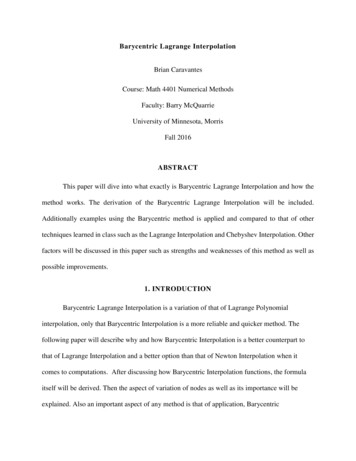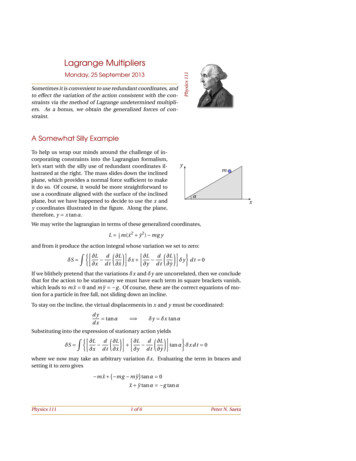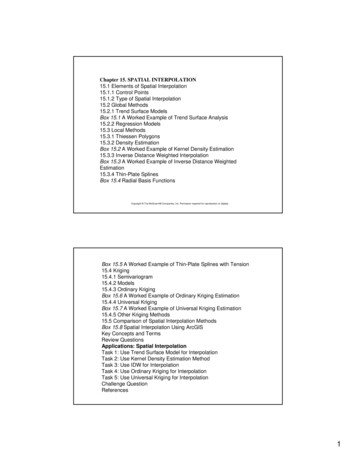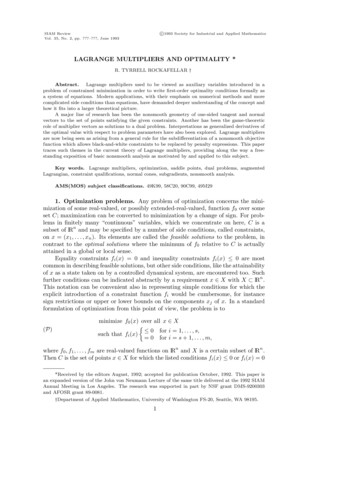
Transcription
Barycentric Lagrange InterpolationBrian CaravantesCourse: Math 4401 Numerical MethodsFaculty: Barry McQuarrieUniversity of Minnesota, MorrisFall 2016ABSTRACTThis paper will dive into what exactly is Barycentric Lagrange Interpolation and how themethod works. The derivation of the Barycentric Lagrange Interpolation will be included.Additionally examples using the Barycentric method is applied and compared to that of othertechniques learned in class such as the Lagrange Interpolation and Chebyshev Interpolation. Otherfactors will be discussed in this paper such as strengths and weaknesses of this method as well aspossible improvements.1. INTRODUCTIONBarycentric Lagrange Interpolation is a variation of that of Lagrange Polynomialinterpolation, only that Barycentric Interpolation is a more reliable and quicker method. Thefollowing paper will describe why and how Barycentric Interpolation is a better counterpart tothat of Lagrange Interpolation and a better option than that of Newton Interpolation when itcomes to computations. After discussing how Barycentric Interpolation functions, the formulaitself will be derived. Then the aspect of variation of nodes as well as its importance will beexplained. Also an important aspect of any method is that of application, Barycentric
interpolation is no different. Although there a multitude of applications, this paper focuses onapplying it to functions and functions of data sets. This paper will touch upon other theoreticalapplications. Lastly this paper touches upon the strengths as well as weakness and possibleimprovements to that of Barycentric Lagrange Interpolation.2. THE METHOD2.1 Lagrange InterpolationWhat will be discussed first is the method of Lagrange Interpolation to give somebackground as what how Barycentric Interpolation came to be. Lagrange interpolation is amethod for dealing with polynomial interpolants. The interpolation starts by letting there existn 1 distinct interpolation nodes (points) 𝑥𝑗 where j 0 n. The assumption can made that allnodes will be real. Also in the Lagrange Interpolation there will exist corresponding numbersthat of 𝑓𝑗. .Where 𝑓𝑗 can be a data set or a function of a data set. To derive the Lagrangian formulathere must exist a vector space 𝑛 such that it will help find a polynomial p Є 𝑛 that willinterpolate 𝑓𝑗 at the nodes where𝑝(𝑥𝑗 ) 𝑓𝑗 ,𝑗 0 𝑛 [ 6 ].As we figured in class and as explained in the Numerical Analysis 2nd edition [ 4 ] the solutionwill be unique and will depend mostly on the data set. The Lagrangian form can then be writtenas(1) 𝑝(𝑥) 𝑛𝑗 0 𝑓𝑗 𝑙𝑗 (𝑥), 𝑛(𝑥 𝑥𝑘 )𝑙𝑗 (𝑥) 𝑛𝑘 0,𝑘 𝑗(𝑥𝑘 0,𝑘 𝑗𝑗 𝑥𝑘 ).Where the Lagrange polynomial 𝑙𝑗 (𝑥) within this interpolation has the parameters,
𝑙𝑗 (𝑥𝑘 ) {1, 𝑗 𝑘0, 𝑜𝑡ℎ𝑒𝑟𝑤𝑖𝑠𝑒𝑗, 𝑘 0, , 𝑛 [ 6 ].Now we will see how Newton’s interpolation works and compare it to Lagrange Interpolation.2.2 Newton’s MethodThe Lagrangian Interpolation method has some shortcomings that will be discussed laterin this paper, but for now we can assume that Lagrange Interpolation is regarded as a theoreticaltool rather than a computational one. For computations we will choose Newton interpolation orNewton’s method of Divided Differences. To approach Newton’s method one must firstformulate Newton’s Tableau of Divided differences. The figure below shows how one mightcompute the divided differences.Figure 1: Newton’s Divided Differences Tableau [4]After refining the figure into a recursive formula of Newton’s method(2) 𝑓[𝑥𝑗 , 𝑥𝑗 1 , 𝑥𝑘 1, 𝑥𝑘 ] 𝑓[ 𝑥𝑗 1 , 𝑥𝑘, ] 𝑓[ 𝑥𝑗 , 𝑥𝑘 1, ]𝑥𝑘 𝑥𝑗,
with the initial condition 𝑓[𝑥𝑗 ] 𝑓𝑗 in order for the tableau equation to work. After all thecalculations have been achieved, then using what is known as the Newton Interpolation formula,(3) 𝑝(𝑥) 𝑓[𝑥0 ] 𝑓[𝑥0 , 𝑥1 ](𝑥 𝑥0 ) 𝑓[𝑥0 , 𝑥1 , 𝑥2 ](𝑥 𝑥0 )(𝑥 𝑥1 ) 𝑓[𝑥0 , 𝑥1 , , 𝑥𝑛 ](𝑥 𝑥0 )(𝑥 𝑥1 ) (𝑥 𝑥𝑛 1 ),then for each x, one can solve the corresponding polynomial 𝑝(𝑥) [ 6 ].2.3 Shortcomings of the Lagrange InterpolationSince this paper wants to implement Barycentric Lagrange Interpolation as the method ofchoice for evaluating polynomial interpolants one must look at what is so wrong with Lagrangeinterpolation. One can look at its shortcomings in two manners, computational speed andreliability. Regarding computational speed, we will say that with each method listed previous,each has a period in which the process can be completed. This process period can be defined inBig O notation, where 𝑂(𝑛) operations means that the process was completed in O timedepending in n time, while 𝑂(𝑛2 ) is completed in n squared time. With this knowledge, we knowthat the regular Lagrange Interpolation is completed in 𝑂(𝑛2 ) operations while Newton’s methodis done in 𝑂(𝑛) operations.If we consider the fact that because Newton’s method can be done in 𝑂(𝑛) operationsthen why can’t standard Lagrange Interpolation formula? This is what motivates an improvementof the standard interpolation formula. Now in terms of reliability the Lagrange Interpolationmethod cannot be trusted because of the Runge Phenomenon it produces with larger degree
polynomials [7][5]. This means that as n gets large there will huge oscillations toward the edgesof the interval where interpolation occurs.2.4 How Barycentric Lagrange Interpolation worksNow that we have the preliminary information behind Barycentric Interpolation we candefine and derive Barycentric Interpolation.Now let𝑙(𝑥) (𝑥 𝑥0 )(𝑥 𝑥1 ) (𝑥 𝑥𝑛 ),where 𝑙(𝑥) isn’t a Lagrange Polynomial but rather the numerator of the polynomial. To continueimproving this formula, we define what will be known as the Barycentric weight as𝑤𝑗 1𝑘 𝑗(𝑥𝑗 𝑥𝑘 ),𝑗 0, 𝑛,1where 𝑤𝑗 𝑙′(𝑥 ). Taking a closer look at equation () we can see this is the denominator of the𝑗Lagrange Polynomial. Now manipulating 𝑙(𝑥) by dividing by 𝑥 𝑥𝑗 and solving for 𝑙𝑗 (𝑥), weobtain the Lagrange Polynomial to be,𝑤𝑙𝑗 (𝑥) 𝑙(𝑥) 𝑥 𝑥𝑗 .𝑗Using equation (1) to evaluate p(x), thus𝑤(4) 𝑝(𝑥) 𝑙(𝑥) 𝑛𝑗 0 𝑥 𝑥𝑗 ,𝑗
making Lagrange Interpolation compute in 𝑂(𝑛) operations when the Barycentric weights i.e.the numbers independent of x are known. It is important to note that if these numbers 𝑤𝑗 are notidentified beforehand than the Lagrange Formula continues to process in 𝑂(𝑛2 ) operations whensolving for 𝑝(𝑥) [1] [7]. The equation above is sometimes known as the first BarycentricFormula or the Modified Lagrange Formula. Equation (4) is not to be confused with a variationof the true form of the Barycentric Formula but rather a prerequisite equation needed to derive it.This equation thus can be changed and derived more finely to achieve another equation.Suppose we interpolate on some data set 𝑓𝑗 , where we our goal is to achieve some sort ofinterpolation where the interpolant returns itself. This can be achieved by using the constantfunction of 1 as 𝑓𝑗 such that𝑤1 𝑛𝑗 0 𝑙𝑗 (𝑥) 𝑙(𝑥) 𝑛𝑗 0 𝑥 𝑥𝑗 .𝑗Now we can divided the equation attained as the Modified Lagrange Formula and divide it by theconstant function, then cancelling 𝑙(𝑥) we achieve the Barycentric Formula,(5) 𝑝(𝑥) 𝑤𝑗𝑓𝑥 𝑥𝑗 𝑗𝑤𝑗 𝑛𝑗 0𝑥 𝑥𝑗 𝑛𝑗 0.Next we will see how the Barycentric Lagrange Interpolation changes depending on the certainnodes chosen when interpolating.3. VARIATION OF NODESUsing the Barycentric formula with different node points will give explicit formulas for theBarycentric Weights 𝑤𝑗 these explicit formulas all derive out to be
𝑛(6) 𝑤𝑗 ( 1)𝑗 ( 𝑗 ),𝑛where the ( 𝑗 ) is the binomial coefficient that expands as𝑛!.(𝑛 𝑗)! 𝑗!To get to this we will start thederivation by choosing equidistant nodes on the interval [-1, 1] with spacing of h 2/n where wecan manipulate the weight to be(𝑤𝑗 𝑛( 1)𝑛 𝑗 ( )𝑗.(ℎ𝑛 𝑛!)Then canceling j terms we get equation (6). Now if we want to get an equation for any interval[a, b] then computation would take place by multiplying by 2𝑛 (𝑏 𝑎) 𝑛 where aftersimplification equation (6) is returned. Now we must consider the fact that like with anypolynomial interpolation, unless the degree of polynomial is low then using equidistant nodescan cause great uncertainty as mentioned before with Lagrangian Interpolation. In the case ofBarycentric Interpolation, the weight will vary exponentially by a factor of 2𝑛 when n is large.The effect this produces is that data near the edges of interpolation interval will have hugeoscillations (Runge Phenomenon). One way to fix the oscillation like with any other polynomialinterpolation one should use sets of clustered nodes such as Chebyshev points [6]. The derivationof changing the Barycentric weight in terms of Chebyshev points is derived in [7] and [6], wherethe weight 𝑤𝑗 turns out to be1(7) 𝑤𝑗 ( 1)𝑗δ𝑗 , δ𝑗 { 21𝑗 0 𝑜𝑟 𝑗 𝑛𝑜𝑡ℎ𝑒𝑟𝑤𝑖𝑠𝑒.
Thus to get the most from Barycentric Lagrange Interpolation one must use clustered points likethat of Chebyshev points. We will see how the variation of nodes takes a role in BarycentricLagrange Interpolation when applying to data sets and functions.4. APPLICATIONSThis Section will touch upon different examples analyzed using Barycentric LagrangeInterpolation and compared to that of other interpolation methods. For most examples listed theresult, process, and explanation of solving them can be found in Appendix A. While theexamples will be listed below. The examples come from either [2] or [3].3.3 Polynomial use with Chebyshev PointsThe data function and question come from [3] and [2].We will analyze the function 𝑓(𝑥) on the interval such that𝑓(𝑥) 𝐶𝑜𝑠(𝑥) 𝑒 𝑥1 5𝑥 2,where we will compare Lagrange Interpolation, Chebyshev Interpolation and BarycentricInterpolation as well as comparing their errors, 𝑓(𝑥) 𝑃(𝑥) . This is one of the most significantexamples because when compared to Barycentric Lagrange Interpolation not only beatsLagrange Interpolation but also Chebyshev Interpolation when comparing errors.3.2 Data SetsData Set 1
The data and question for this data set come from [3] and 51,326179,323203,302226,542249,633(Thousands)Table 1:Find the 5th degree Lagrange Polynomial fitting this data. We will analyze this data and compareusing the Barycentric Lagrange Interpolation.Data Set 2The data and question for this data set come from [3] and 27.197.277.347.447.547.95 8.49 8.89Compressibility[𝑇𝑃𝐴] 1Table 2:Find the 8th degree Lagrange Polynomial fitting this data. We will analyze this data and compareusing the Barycentric Lagrange Interpolation.Data Set 3 Oscillations (wiggles)The data and question for this data set come from [2].We are given a data set with significant oscillations inside the region we want to interpolate andwill fix the oscillations using Barycentric Lagrange Interpolation.
3.3 Continuous function with Equidistant NodesThe data function comes from [2]. This example started by using a module in Mathematica forLangrangian Interpolation of equally spaced nodes where oscillations again occur. We will seethat with Barycentric Lagrange Interpolation, the oscillations diminish.3.4 Other ApplicationsBarycentric Lagrange Interpolation not only can be applied to computation but additionally usedwith theoretical tools such as Differentiation of Polynomial Interpolants, Rational Interpolationand Fast Multipole Methods. For more detailed explanation of the use of BarycentricInterpolation in these methods as well as other see [7].5. CONCLUSIONMoreover Barycentric Lagrange Interpolation is the reliable and quick tool forapproximating polynomial interpolants. The Barycentric formula is derived from that ofLagrange Interpolation and builds upon it to improve the method. Barycentric LagrangeInterpolation is in terms of computational speed, and operations faster than that of its counterparts. Barycentric Interpolation computes in 𝑂(𝑛) operations. This speed is quicker than that ofLagrangian Interpolation and just as fast as Newton Interpolation, if not faster whencomputing 𝑝(𝑥). Additionally Barycentric is more reliable as seen in Applications section andAppendix A where it approximates a better polynomial with a lower error when compared toChebyshev Interpolation. Although Barycentric Interpolation is a highly reliable interpolating
tool it does have its weaknesses such as when 𝑥 𝑥𝑗 where an indeterminate form appearswhich nothing can really be done about it. The only fix is that since most interpolation is donewith computer programs, an “if” statement should be included to catch this problem and justreturn the data. Since Barycentric Lagrange Interpolation should be the method of choice theonly improvement that should be considered has already been iterated. For improvement sets ofclustered nodes should be used with Barycentric Interpolation for best results. FurthermoreBarycentric Lagrange Interpolation is the method to choose when it comes to approximatingpolynomial interpolants.
REFERENCES1. Higham, Nicholas. J. "The Numerical Stability of Barycentric LagrangeInterpolation." IMA Journal of Numerical Analysis (2004) 24, 547–556 (2004): n.pag. Http://www.maths.manchester.ac.uk/ higham/narep/narep440.pdf. IMAJournal of Numerical Analysis. Web. 11 Nov. 2016.2. McQuarrie, Barry. LectureLagrangeInterpolation, LectureChebyshevInterpolation,Assignment3 Solutions. Mathematica. Sept. 2016.3. McQuarrie, Barry. Numerical Methods Assignment3, PDF. Sept. 2016.4. "Newton Polynomial." Wikipedia. Wikimedia Foundation, n.d. Web. 20 Nov. 2016.5. " Sauer, Timothy. "Chapter 3:Data and Interpolating Functions." Numerical Analysis. 2nded. Boston: Pearson, 2012. 139-66. Print.6. Trefethen, Lloyd N. PDF. N.p.: n.p., n.d. Approximation Theory and ApproximationPractice. Web. 11 Nov. 2016.7. Trefethen, Lloyd N., and Jean-Paul Berrut. PDF. N.p.: 2004 Society for Industrial andApplied Mathematics, 2004. Web. 11 Nov. 2016.
Lagrange Interpolation but also Chebyshev Interpolation when comparing errors. 3.2 Data Sets Data Set 1 . The data and question for this data set come from [3] and [2]. Year 1940 1950 1960 1970 1980 1990 Population (Thousands) 132,165 151,326 179,323 203,302 226,542 249,633 Table 1: .










